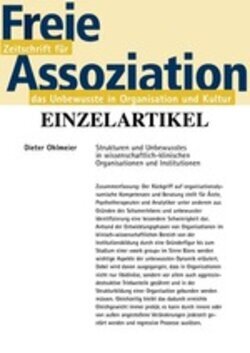14 Seiten, PDF-E-Book
Erschienen: November 2004
Bestell-Nr.: 21034
abonnieren
Dieter Ohlmeier
Strukturen und Unbewusstes in wissenschaftlich-klinischen Organisationen und Institutionen (PDF)
Freie Assoziation 2004, 7(3), 5-18
Sofortdownload
Dies ist ein E-Book. Unsere E-Books sind mit einem personalisierten Wasserzeichen versehen,
jedoch frei von weiteren technischen Schutzmaßnahmen (»DRM«).
Erfahren Sie hier mehr zu den Datei-Formaten.
Der Rückgriff auf organisationsdynamische Kompetenzen und Beratung stellt für Ärzte, Psychotherapeuten und Analytiker unter anderem aus Gründen des Schamerlebens und unbewusster Identifizierung eine besondere Schwierigkeit dar. Anhand der Entwicklungsphasen von Organisationen im klinisch-wissenschaftlichen Bereich von der Institutionsbildung durch eine Gründerfigur bis zum Stadium einer »work group« im Sinne Bions werden wichtige Aspekte der unbewussten Dynamik erläutert. Dabei wird davon ausgegangen, dass in Organisationen nicht nur libidinöse, sondern vor allem auch aggressivdestruktive Triebanteile gezähmt und in der Strukturbildung einer Organisation gebunden werden müssen. Gleichzeitig bleibt das dadurch erreichte Gleichgewicht immer prekär, es kann durch innere oder von außen angestoßene Veränderungen jederzeit gestört werden und regressive Prozesse auslösen.
Abstract:
Working with psychodynamic concepts and psychoanalytically- informed consultation appears especially difficult for physicians, psychotherapists, and psychoanalysts, due to their experience of shame and unconscious identifications. This paper traces the unconscious organizational dynamics present in the development of an organization where clinical and scientific work takes place – from its inception by ist founding father to the stage of a ›work group‹ (in the Bion sense). The author posits that not only libidinal, but also aggressive and destructive, drives need to be tamed in an organization and have to be bound by ist structure. At the same time, the equilibrium reached thereby remains in a perilous state; it can be shattered again and again due to internal changes or to forces from the environment, which once more arouse regressive processes.
Abstract:
Working with psychodynamic concepts and psychoanalytically- informed consultation appears especially difficult for physicians, psychotherapists, and psychoanalysts, due to their experience of shame and unconscious identifications. This paper traces the unconscious organizational dynamics present in the development of an organization where clinical and scientific work takes place – from its inception by ist founding father to the stage of a ›work group‹ (in the Bion sense). The author posits that not only libidinal, but also aggressive and destructive, drives need to be tamed in an organization and have to be bound by ist structure. At the same time, the equilibrium reached thereby remains in a perilous state; it can be shattered again and again due to internal changes or to forces from the environment, which once more arouse regressive processes.
Dieter OhlmeierS. 5–18Strukturen und Unbewusstes in wissenschaftlich-klinischen Organisationen und Institutionen (PDF)
Freie Assoziation 2004, 7(3), 5-18Tomas PlänkersS. 19–35Das Sigmund-Freud-Institut: Geschichte und Organisationsdynamik (PDF)
Freie Assoziation 2004, 7(3), 19-35Thomas AuchterS. 37–58Zur Psychoanalyse des Möglichkeitsraumes ›Potential Space‹ (PDF)
Freie Assoziation 2004, 7(3), 37-58Peter JüngstS. 59–79Zur Eskalierung des Konflikts zwischen westlicher und arabischislamischer Welt - Überlegungen zum psychosozialen »Input« beider Seiten (PDF)
Freie Assoziation 2004, 7(3), 59-79Bernd OberhoffS. 81–100Mozarts Don Giovanni - was rächt er an den Frauen? (PDF)
Freie Assoziation 2004, 7(3), 81-100Günter FranzenS. 101–111Vor den Müttern sterben die Söhne - Marginalien zu einer demographischen Randerscheinung (PDF)
Freie Assoziation 2004, 7(3), 101-111
Freie Assoziation 2004, 7(3), 5-18Tomas PlänkersS. 19–35Das Sigmund-Freud-Institut: Geschichte und Organisationsdynamik (PDF)
Freie Assoziation 2004, 7(3), 19-35Thomas AuchterS. 37–58Zur Psychoanalyse des Möglichkeitsraumes ›Potential Space‹ (PDF)
Freie Assoziation 2004, 7(3), 37-58Peter JüngstS. 59–79Zur Eskalierung des Konflikts zwischen westlicher und arabischislamischer Welt - Überlegungen zum psychosozialen »Input« beider Seiten (PDF)
Freie Assoziation 2004, 7(3), 59-79Bernd OberhoffS. 81–100Mozarts Don Giovanni - was rächt er an den Frauen? (PDF)
Freie Assoziation 2004, 7(3), 81-100Günter FranzenS. 101–111Vor den Müttern sterben die Söhne - Marginalien zu einer demographischen Randerscheinung (PDF)
Freie Assoziation 2004, 7(3), 101-111

